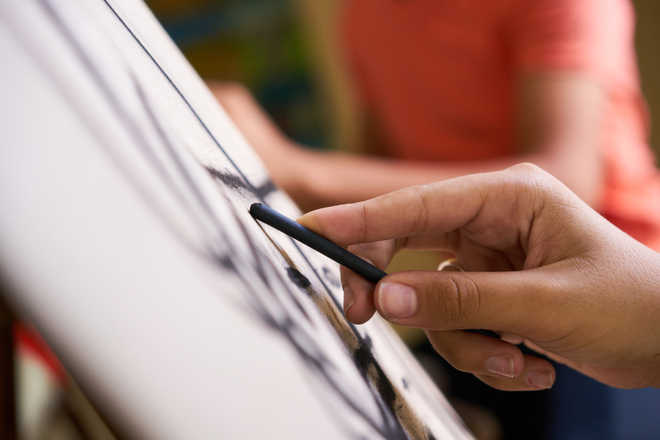
How it works: An activity like painting enhances our mental flexibility, enabling us to reflect upon trauma and distress
Harsuchetan Kaur
A 28-year-old woman understood the problems about her body and could talk at length about it. She said she wanted to lose weight to feel confident. She had tried making schedules but just couldn’t follow them.
In one of the sessions, she picked up a sketch pen and, on a chart paper, drew her whole body, systematically, giving metaphors to each part. By the end of the little exercise, she felt better. She said she was able to reflect upon the body parts she had a negative image about; the metaphors helping her in that. That is art-based therapy for you.
Spoken language, which is based upon a system of shared meaning, leaves hardly any space for subjective meaning making. However, this therapy uses non-verbal ways of expressing emotions that one is ashamed or fearful or resentful of or is not consciously aware of, etc. Drawing helped the young woman look at her relationship with her body in both positive and negative light. She loved her eyes, her hands and other parts, but not her lower abdomen and thighs. The metaphors created a space for reflection, not just to find the probable cause (sexual abuse or stereotyped oppressive market standard of ideal body and beauty), but also opened her mind towards her own ideas about her body. When the session was over, she said, “You know, I have never looked at my body in this manner.”
Emotional, physical and sexual abuse in intimate relationships plays a significant role in the manifestation of mental health issues. Consider an expression like “I am sad”. It varies from person to person. Not only the logical conclusion of the cause of sadness, but also the quality of sadness. To express this subjective quality of meanings, art material and creative activities designed with therapeutic goals in mind, have proven to be beneficial.
A small change, a shift in one’s ways of seeing, brings in flexibility and openness. With the creative processes, one’s problem-solving capacity increases. A teenager who was still in the process of diagnosis had trouble expressing her emotions and I was informed she does not like to be told what she should do or not do. After a few sessions, we did a little role play of ideal self-care. She imagined a regular day of a school-going girl and performed an ideal day according to her. The creative process of reflecting on an ideal day helped her face her own idea of self care, some elements of which she wasnt practising in her daily life.
While working with teenagers and young adults, it is important to work on changing violent and oppressive communication patterns within the family. Also, dissolving the stigma and shame related to sexual expression and orientation is important for prevention and healing of mental health issues. The silence around child sexual abuse needs to be broken.
Painting, drawing, playing, body movements, music, role play, etc. enhance our mental flexibility, which plays a key role in enabling us to reflect upon trauma and distress in the safe environment of a therapeutic set up. Arts-based therapy uses different art material and creative activities to express and reflect upon emotions with a therapist. This process also brings to surface thoughts that one had not thought of before thus enhancing the quality of healing.
The practice of mindfulness is an important tool in arts-based therapy. Let us explain this with an example. Tara (name changed) got angry at her sister over something. “At that moment, a thought occurred — I am angry now. That little second gave me a choice of whether to understand the situation and respond or to continue rolling in my angry thoughts. I chose to calmly explain to my sister what the problem was and she was more receptive.” Practising mindfulness helps in self-awareness, self-reflection and responsiveness.
Artistic expression and practice of mindfulness in a therapeutic set up with the care and guidance of a therapist helps in healing from distress and other mental health problems. It can be used as an independent intervention modality or an adjunctive therapy. Wars, violence, exploitation, abuse on the basis of caste, sexuality, gender, class, religion, erodes our emotions in varying intensity. In the face of such oppression, one needs to build resilience with care and creativity



























